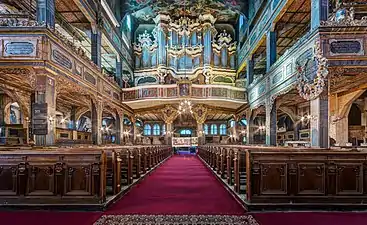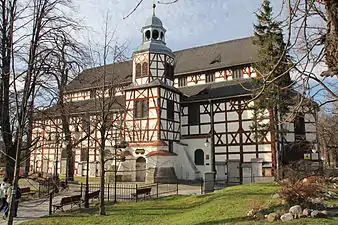Churches of Peace
The Churches of Peace (Polish: Kościoły Pokoju, German: Friedenskirchen) in Jawor (German: Jauer) and Świdnica (German: Schweidnitz) in Silesia were named after the Peace of Westphalia of 1648.
| UNESCO World Heritage Site | |
|---|---|
 Church of Peace in Świdnica | |
| Location | Lower Silesian Voivodeship, Poland |
| Criteria | Cultural: iii, iv, vi |
| Reference | 1054 |
| Inscription | 2001 (25th session) |
It permitted the Lutherans of Silesia to build three churches from wood, loam and straw outside the city walls, without steeples and church bells. The construction time was limited to one year. The third Peace church, erected in Głogów (then German Glogau), burned down in 1758.
Since 2001, the two remaining churches are listed as UNESCO World Heritage Sites.
History
Despite the physical and political constraints, three of the churches became the biggest timber-framed religious buildings in Europe due to pioneering constructional and architectural solutions.
The church in Jawor, dedicated to the Holy Ghost is 43.5-metre (143 ft) long, 14-metre (46 ft) wide and 15.7-metre (52 ft) high and has capacity of 5,500. It was constructed by architect Albrecht von Saebisch (1610–1688) from Wroclaw (then German Breslau) and was finished a year later in 1655. The 200 paintings inside by were done by Georg Flegel in 1671–1681. The altar, by Martin Schneider, dates to 1672, the original organ of J. Hoferichter from Legnica (then German Liegnitz) of 1664 was replaced in 1855–1856 by Adolf Alexander Lummert.
By that time, the town had been part of the majority Protestant Kingdom of Prussia for about a century. Another 100 years later, in 1945, the town became part of Poland, as a result of the Potsdam Agreement. Although most of the Protestant churches in the German provinces taken over by Poland in 1945 became Catholic, the two Peace Churches still serve their Lutheran parishes.
The similar church, erected in Głogów (then German Glogau) burned down in 1758, but the one in Świdnica, dedicated to the Holy Trinity, survived like the one in Jawor. Both were restored by a Polish–German cooperation, and recognized by UNESCO in 2001.
- The three Churches of Peace (around 1750)
 Glogau (Głogów)
Glogau (Głogów) Jauer (Jawor)
Jauer (Jawor) Schweidnitz (Świdnica)
Schweidnitz (Świdnica)
Gallery
Świdnica

 Main altar
Main altar

Jawor

 Organ
Organ Main altar
Main altar
Surroundings
- Gola Dzierżoniowska Castle
- Medieval town of Niemcza
- Cistercian monastery at Henryków
- Wojsławice Arboretum
Bibliography
- Worthmann, Ludwig, Führer durch die Friedenskirche zu Schweidnitz. Breslau 1929.
- Kalinowski, Konstanty, Barock in Schlesien. München 1990. ISBN 3-422-06047-2.
- Gruk, Wojciech, Silesian Churches of Peace and the Royal Hungarian Articular Churches. Possible Legal and Architectural Relations. In: Protestantischer Kirchenbau der Frühen Neuzeit in Europa. Grundlagen und neue Forschungskonzepte. — Protestant Church Architecture in Early Modern Europe. Fundamentals and New Research Approaches. Regensburg 2015, p. 333-343. ISBN 978-3-7954-2942-3.
External links
| Wikimedia Commons has media related to Churches of Peace. |
